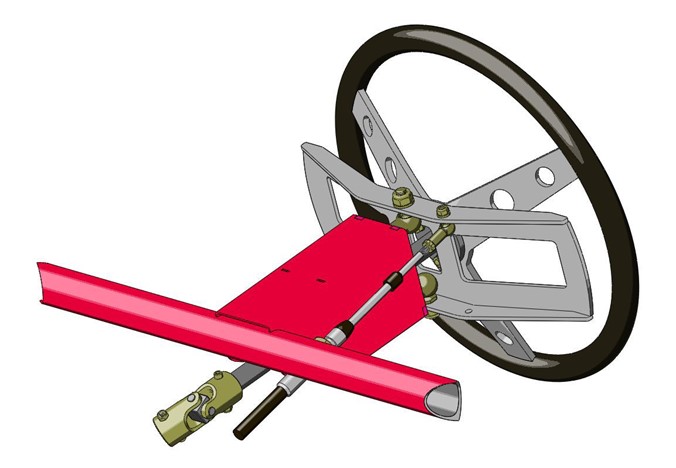Unless you also race in some high-end track events, or you have a friend who does, you’re unlikely to have a set of levelling pads and electronic scales. Perhaps you’ve tried the four short planks and four bathroom scales approach, with varying results? Fear not! The following method of balancing a buggy is so simple even I can do it, and it’s really quite accurate.
All you need to do the job are some lengths of RHS steel, a bit of steel angle, a couple of boards, and a builder’s level. You need to be as acurate as possible with all measurements, levelling and plumbing to get the best results.
Weld the steel balance frame together as in the Balance Frame drawing in your plans (or below for download), and tack weld the piece of angle in place. Take care not to get too much heat into the centre of the frame, which could cause the frame to bow. This frame can be modified to suit any width buggy, the overall length needs to be wider than the the outside measurements on the widest axle including the tyres you are using. When constructing the Balance Frame for smaller tyred buggies make sure that the width is narrow enough that the tyres do not touch the ground when the buggy is sitting in the frame. The frame acts like a see-saw with a wheel at each end and steel angle as the central fulcrum. Select a few boards just longer than the buggy’s track. Spend a few minutes and find a level area on the floor to represent the wheelbase, and track of the buggy.
Lay a board on the floor, and stack a few on top, to the same overall height as the balance frame you’ve made (measured over the centre fulcrum).
Before you begin the balancing process you should make sure that the buggy is race-ready; fluid levels need to be topped up, tyre pressures checked, ride height adjusted, caster and camber set, and the toe checked. Last, but not least, the fully kitted driver will also need to be in the driving seat.
Grab your “C” spanners if using coil overs, and slack off the locking rings on the shocks’ spring seats. While you’re at it, give the shock threads a light spray of WD40, so the spring seats will turn nice and easily. Alternatively, if you’re using air (nitrogen) shocks, have your source of nitrogen ready.
Jack the rear of the buggy up, and slide the stack of boards under the rear tyres. Check the top board is absolutely level in both directions, and shim if necessary (use incompressable material for shims not carboard). Now jack the front of the buggy up, and slide the balancing frame under the front tyres. Ideally you should also level between the balance bar at the front and boards at the rear. To do this the balance bar must be temporarily chocked in the level position without the weight of the front wheels. Adjust the boards with shims not the bar and then remove the chocks before proceeding.
Drop a plumb line from the centre mark on the front of the buggy, to ensure it’s sitting centrally on the frame as you lower it from the jack onto the balance frame. Very gently, bounce the front of the buggy a few times, to insure that there is no suspension bind, and the shocks are not hanging up. Try to do the settling procedure consistently as this will help you obtain repeatable results. From this point on, avoid disturbing the buggy; no sitting on it, or leaning up against it, otherwise you could possibly get false readings.
It’s more than likely that the wheel weights are all different. It’s of no concern if both axles don’t weigh the same, but it’s important to try and achieve equal weights on the same axle.
When adjusting the wheel weights, it’s important not to lose sight of the ride height. It’s very easy to wind the spring perches down (increase nitrogen pressure) so the wheel weights are equal, but in the process, the ride height may be increased.
The balance frame will tip down on the side of the heavier of the two front wheels. If you raise the ride height at one corner, the weight on that corner will increase, as will the weight on the diagonally opposite corner. The weight on the other two corners will be reduced.
The idea is to adjust the spring seats until the balance frame is level. Start with the lightest of the four wheels, and screw the spring seat down (increase nitrogen pressure), thereby preloading the spring and increasing the pressure on the wheel. Check the top edge of the balance frame with the builder’s level frequently. Make only very small changes at a time, as any changes will affect the other wheel weights. Do not level by measurement off the ground unless you have a perfectly level surface you’re working from.
Every so often, check the ride height, and if it’s rising, raise the spring seat (drop the nitrogen pressure) of the heaviest wheel to compensate for screwing down the lighter one. Keep adjusting the spring seats until the balance frame is dead level. Do not tighten the locking rings yet!
Repeat the whole process on the rear end, and then check the front again one last time. When you’re satisfied with the results, tighten all the locking rings against their spring seats.
Note: The buggy will need to be balanced again after any alterations or repairs are made to the suspension.



